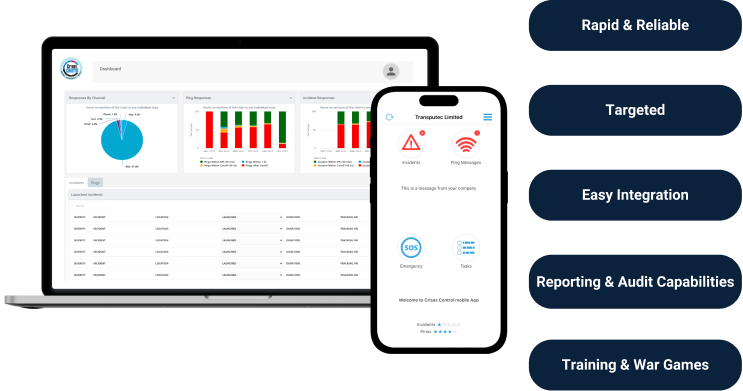In the face of a crisis, swift and coordinated action is paramount. When an evacuation becomes necessary, ensuring a smooth and efficient process can minimise confusion, prevent injuries, and even save lives.
This blog delves into the intricacies of crafting a robust evacuation plan, exploring the essential components, its benefits, and how Crises Control’s industry-leading mass notification software empowers organisations to orchestrate a calm escape during emergencies.
The Anatomy of an Evacuation Process
An evacuation process is a meticulously crafted roadmap outlining the actions personnel must take to safely exit a building or area during an emergency. Here’s a breakdown of its key elements:
- Triggering the Evacuation: Clearly defined triggers, such as fire alarms, chemical spills, or active shooter situations, must initiate the evacuation plan.
- Communication and Notification: Timely and effective communication using a reliable mass notification system is vital. This ensures everyone is aware of the emergency and the need to evacuate.
- Designated Evacuation Routes: Pre-determined evacuation routes should be clearly marked and easily accessible. Alternative routes should also be established to account for blocked exits or situations requiring occupants to shelter in place.
- Assembly Points: Designated assembly points outside the affected area provide a safe space to account for personnel and assess the situation.
- Headcount and Accountability: Procedures for conducting headcounts at assembly points ensure everyone has been evacuated safely.
- Training and Drills: Regular evacuation drills familiarise personnel with the plan, fostering a culture of preparedness and reducing panic during a real-life event.
- Post-Incident Review and Updates: Debriefing after an evacuation drill or real-world event helps identify areas for improvement and ensures the plan remains up-to-date.
Why is a Streamlined Evacuation Process Critical?
A well-defined evacuation plan offers a multitude of benefits for organisations:
- Enhanced Life Safety: A clear and efficient evacuation process minimises confusion and panic, allowing personnel to exit a building quickly and safely.
- Reduced Liability: A documented and practised evacuation plan demonstrates an organisation’s commitment to employee safety, potentially mitigating legal repercussions in the event of an incident.
- Improved Business Continuity: A swift and controlled evacuation minimises downtime and allows for a quicker resumption of operations once the crisis has abated.
- Boosted Employee Morale: A well-rehearsed evacuation plan fosters a sense of security and trust within the organisation, knowing management prioritises their safety.
Evacuation for Diverse Incidents
Evacuation plans are not solely for fire emergencies. They can be implemented for various critical events, including:
- Fire: This is the most common evacuation scenario, and a well-defined plan ensures everyone knows how to exit the building safely in the event of a fire alarm.
- Natural Disasters: Evacuation plans become crucial during natural disasters like hurricanes, floods, or earthquakes, ensuring personnel can reach safe havens.
- Active Shooter Situations: Swift evacuation procedures are essential in the event of an active shooter, allowing occupants to escape the immediate threat.
- Chemical Spills or Leaks: Evacuation plans are vital for chemical incidents, protecting employees from exposure to hazardous materials.
- Utility Outages: Evacuation may be necessary during prolonged utility outages, particularly when life support systems are compromised in healthcare facilities.
How Crises Control Empowers Your Evacuation Process

Crises Control’s Ping Mass Notification Software serves as a cornerstone for effective crisis management and evacuation procedures. Here’s how Ping empowers your organisation:
- Rapid and Reliable Communication: Ping delivers critical evacuation messages instantly through multiple channels, including SMS text, email, voice calls, push notifications, and desktop alerts. This ensures everyone receives the notification, regardless of location or device.
- Targeted Communication: Segmenting messages allows you to send targeted evacuation instructions to specific departments or floors within a building, ensuring clarity and avoiding unnecessary confusion.
- Two-Way Communication: Ping facilitates two-way communication, allowing personnel to acknowledge receipt of the evacuation message or report any issues encountered during the evacuation process.
- Real-Time Tracking (Optional): With Crises Control’s optional real-time tracking feature, you can monitor employee locations during an evacuation, enabling faster response and headcount verification.
- Integration with Building Systems: Ping seamlessly integrates with existing building security systems, automatically triggering notifications upon activation of fire alarms or other emergency triggers.
Streamlining Your Evacuation Process with Crises Control
Crises Control offers a comprehensive suite of tools designed to streamline your organisation’s evacuation process. By leveraging Ping Mass Notification Software and our expert guidance, you can:
- Develop a Comprehensive Evacuation Plan: Our team can assist you in crafting a customised evacuation plan tailored to your specific needs and facility layout. We’ll work with you to identify potential hazards, establish clear evacuation triggers, and map out designated escape routes and assembly points.
- Facilitate Employee Training: Crises Control provides training materials and workshops to educate your workforce on the evacuation plan. These interactive sessions familiarise employees with their roles and responsibilities during an evacuation, fostering a culture of preparedness and reducing anxiety in real-world scenarios.
- Conduct Evacuation Drills: Regularly scheduled evacuation drills are crucial for testing the effectiveness of your plan and identifying areas for improvement. Crises Control can guide you through the drill process, ensuring a realistic simulation that exposes potential bottlenecks or communication breakdowns.
- Conduct Regular Audits and Reporting: As your organisation and its physical environment change, so should your evacuation plan. Crises Control supports you in maintaining a current plan by facilitating regular audits to identify any necessary updates due to changes in personnel, building layout, or local regulations. These audits can be documented and used to generate reports that track revisions and ensure your plan remains compliant and effective.
Beyond Evacuation: The Power of Crises Control in Crisis Management
While evacuation is a critical component of crisis management, Crises Control’s Ping Mass Notification Software offers a broader range of functionalities to empower your organisation’s overall preparedness:
- Incident Management: The incident manager module facilitates real-time communication during a crisis. This enables swift response coordination and information dissemination to all stakeholders, ensuring everyone is informed and can take appropriate action.
- Business Continuity: The software aids in restoring normal operations after a crisis by facilitating communication with employees, customers, and partners, keeping everyone informed and minimising disruption.
- Regulatory Compliance: Crises Control helps ensure your organisation adheres to relevant emergency notification regulations, mitigating potential legal ramifications.
Investing in a Culture of Preparedness
A well-defined evacuation process coupled with a robust mass notification system empowers your organisation to respond effectively to crises. Crises Control equips you with the tools and expertise necessary to navigate emergencies calmly and efficiently, safeguarding your people and ensuring business continuity.
Ready to Streamline Your Evacuation Process?
Contact Crises Control today for a free personalised demo and discover how we can help you craft a comprehensive evacuation plan and cultivate a culture of preparedness within your organisation. With Crises Control as your partner, you’ll be empowered to face any crisis with confidence.
Request a FREE Demo
Interested in Crises Control?
FAQs
1. What are the key elements of a well-defined evacuation plan?
A well-defined evacuation plan outlines procedures for safely exiting a building during emergencies. Key elements include designated triggers for evacuation, clear communication protocols using a mass notification system, predetermined escape routes and assembly points, headcount procedures, and regular training drills to ensure everyone is familiar with the plan.
2. Why is a streamlined evacuation process important for organisations?
A streamlined evacuation process offers numerous benefits. It minimises confusion and panic during emergencies, safeguarding lives. It demonstrates a commitment to employee safety, potentially reducing liability. It allows for a quicker resumption of operations after a crisis and fosters a sense of security among employees.
3. What types of emergencies can an evacuation plan address?
Evacuation plans are not just for fires. They can be implemented for various critical events, including natural disasters, active shooter situations, chemical spills, and utility outages.
4. How can Crises Control’s Ping Mass Notification Software improve an evacuation process?
Ping ensures rapid and reliable communication by delivering evacuation messages through multiple channels. It allows for targeted communication to specific areas and facilitates two-way communication to confirm receipt of messages or report issues. Additionally, optional real-time tracking can help monitor employee locations during evacuation.
5. How can Crises Control help my organisation develop a comprehensive evacuation plan?
Crises Control offers a multi-pronged approach. They assist in crafting a customised evacuation plan tailored to your specific needs. They provide training materials and workshops to educate employees. They guide you through conducting evacuation drills to test the plan’s effectiveness. Finally, they help maintain and update the plan to reflect any changes in your organisation or surroundings.







